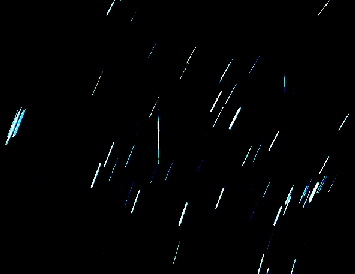
November 18, 2001. The Leonid meteor shower. I wake up at 3 a.m., throw a wool coat over my flannel pajamas, put my fringed suede gloves on, and pull some blankets out of the linen closet. I’m quiet about it. I don’t want to disturb my husband.
I go outside and drag a wooden Adirondack from the backyard to the end of the driveway. I’m supposed to watch the constellation Leo, but I want to see the meteors fly over the San Francisco Peaks, so I turn my chair to the west. I settle in, wrap myself in blankets. I lie back and look up, wait. The sky is clear, perfect.
I’ve seen meteor showers before—I track my years through the Perseids in August, the Orionids in October, the Geminids in December—but none of them prepared me for this. Dashes of light slicing through the sky, so many per second that I can’t keep up. As soon as my vision catches one, another appears. It is dazzling. The most beautiful thing ever. I am lightheaded in the cold, aware that the atoms composing my body came from stars that died 10 billion years ago. I feel as if the meteors are not streaking down toward me, but are moving up, through me, to arc in the sky, pulling me with them. I am breathless, shaking. I close my eyes and try to imprint a memory.
*
November 18, 2001. The Leonid meteor shower. At 6 a.m., my husband wakes me up and says, “You missed your meteor shower.”
“I saw it,” I say. “I got up at 3.”
“No, you didn’t,” he says.
I get out of bed. My coat is in the closet. I remember that I lost the fringed suede gloves last winter. The blankets haven’t been touched. The Adirondack chair sits on the back porch, unmoved.
Inexplicably, I think of Henry James. The Jamesian equation, as I see it, may be expressed thus: observation + imagination = experience.
I’ve seen enough meteor showers to know what one looks like. My imagination does the rest, builds a planetarium for me as vivid and real as the Leonids sky. And can it not be further argued that everything that leads us to fully imagine the possibility of a thing is as valuable as the thing itself? Is, itself, a thing. Like the stars that dreamed of us.
“I did see it,” I tell my husband. And I did.
Jane Armstrong’s work has appeared in Newsweek, The North American Review, Beloit Fiction Journal, New Orleans Review and elsewhere. She teaches at Northern Arizona University and is an editor at the Mississippi Review.
